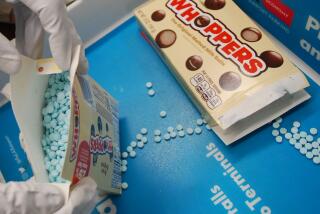FAA’s New Bomb Detector Flawed, Researchers Say
- Share via
The expensive new bomb detectors that the Federal Aviation Administration is requiring to be installed at major airports have an unacceptably high rate for false detection of bombs in passenger luggage and are probably not sensitive enough to detect bombs of the size that downed Pan Am Flight 103 over Lockerbie, Scotland, last year, researchers said Thursday.
One of the new $1-million detectors will begin operation today at Kennedy Airport in New York City, and the FAA is purchasing five more for installation in San Francisco, Miami, London and Frankfurt. In the next decade, the FAA may require installation of at least 400 detectors at 40 international airports, including Los Angeles International.
A high false positive rate produced by the technique, called thermal neutron analysis or TNA, means that large numbers of suitcases would have to be opened and checked by hand, creating nightmare delays at large airports.
Investment in Billions
The detectors, which weigh nine tons, and associated equipment will also require large amounts of space at already overcrowded airports, as well as a financial investment estimated by the Air Transport Assn. of America to total as much as $4.5 billion over the next 10 years.
Finally, critics charge that the massive investment, combined with the FAA’s requirement that only thermal neutron analysis be used for the next 10 years, may choke off efforts to develop more reliable detectors using better technology.
But the thermal neutron analysis developer, Tsahi Gozani of Science Applications International Corp. of Santa Clara, dismisses the criticism.
“Given that there is a threat (from terrorists), putting in an imperfect system is far better than doing nothing, especially in view of the fact that TNA can become better and better,” he said.
Rep. Cardiss Collins (D-Ill.), one of the prime critics of implementing thermal neutron analysis technology, has scheduled hearings on the FAA requirement for later this month, and critics are expected to seek delays in implementation of the rules to allow more time for development of alternative technologies.
No one denies that the threat to airline passengers from terrorist bombs is omnipresent. The question is how best to respond to the threat with limited resources, without grossly disrupting airline schedules and with some hope of success.
“To spend half a billion dollars or more for a system that wouldn’t have saved the Pan Am victims--that’s crazy,” said Collins’ legislative assistant, Edith Holleman, who has been investigating thermal neutron analysis.
The heart of the current dispute involves the size and shape of bombs that might be used by terrorists. When the FAA first requested proposals for bomb detectors earlier in this decade, safety experts assumed that a bomb would have to be fairly big to severely disable airliners.
The FAA therefore asked for detectors that would pick up about 2.5 pounds of explosives, according to physicist Lee Grodzins of the Massachusetts Institute of Technology, who is an FAA consultant. But experts are finding that smaller bombs can be equally devastating.
In an investigation of thermal neutron analysis technology published today, Science magazine reported that experts now believe that the Pan Am bomb, which killed 270 people last December in Scotland, actually weighed less than one pound. Similarly small bombs killed one passenger and injured 15 on a Pan Am flight to Hawaii in August, 1982, and blew a hole in the side of a TWA plane in April, 1986, killing four passengers.
“And so the question as far as TNA is concerned is can the people who designed this very fine system, which met the criteria it was designed to meet, improve it to meet what people think are new threats?” Grodzins asked. “We just don’t know.”
The problem is that thermal neutron analysis does not specifically detect bombs, it detects the element nitrogen, which is present in explosives, but which also is present in a large number of other materials, including cotton, wool, nylon, leather, foods and, especially, plastic ski boots.
Detection Limit
Operating at a detection limit of 2.5 pounds, the TNA detectors will identify about 95% of all bombs with a false positive rate of 4% to 5%. As a rule of thumb, a false positive rate of 5% means that about 30 bags would have to be inspected on a typical jumbo jet flight.
Experts agreed that thermal neutron analysis is less effective at detecting plastic explosives, which are most often favored by terrorists, and that it has special problems detecting plastic explosives formed into large thin sheets.
If the detection limit has to be lowered to reflect the fact that terrorists now use smaller bombs, the false positive rate will go up “dramatically,” Gozani conceded, and much larger numbers of bags will have to be searched by hand.
“TNA will detect any level of explosives that you want to detect,” he said, “but you have to answer the second question, is the trade-off acceptable? Does this make the system unusable? In Switzerland, they already search 25% of the bags by hand. TNA will give you a reason to open those bags.”
Took Time
Cost and installation of the detectors may also be a problem. According to Richard F. Lally, vice president security at the Air Transport Assn., installation of the one detector at TWA’s terminal at Kennedy Airport required construction of a 19-by-40-foot building on the ramp outside the terminal at a cost of more than $126,000. Construction took a year longer than expected.
TWA estimates that it will require 10 additional machines to handle peak passenger demand at Kennedy, Lally said, and it simply does not have the space for them without completely remodeling the terminal.
Newer, more effective technologies for detecting explosives are under development by the FAA and private industry, but none has been demonstrated yet.
FIRM MAY BENEFIT--FAA ruling may be a windfall for a San Diego firm that makes high-tech bomb detectors. Part IV, Page 2
More to Read
Sign up for Essential California
The most important California stories and recommendations in your inbox every morning.
You may occasionally receive promotional content from the Los Angeles Times.













